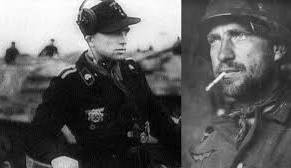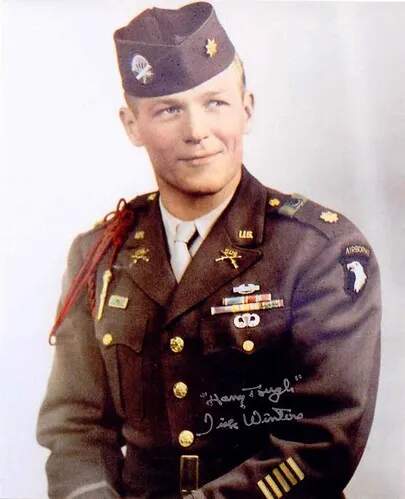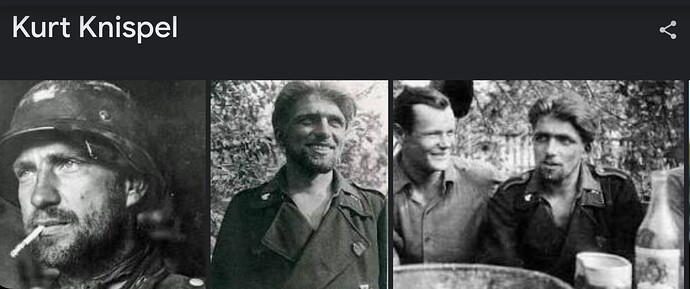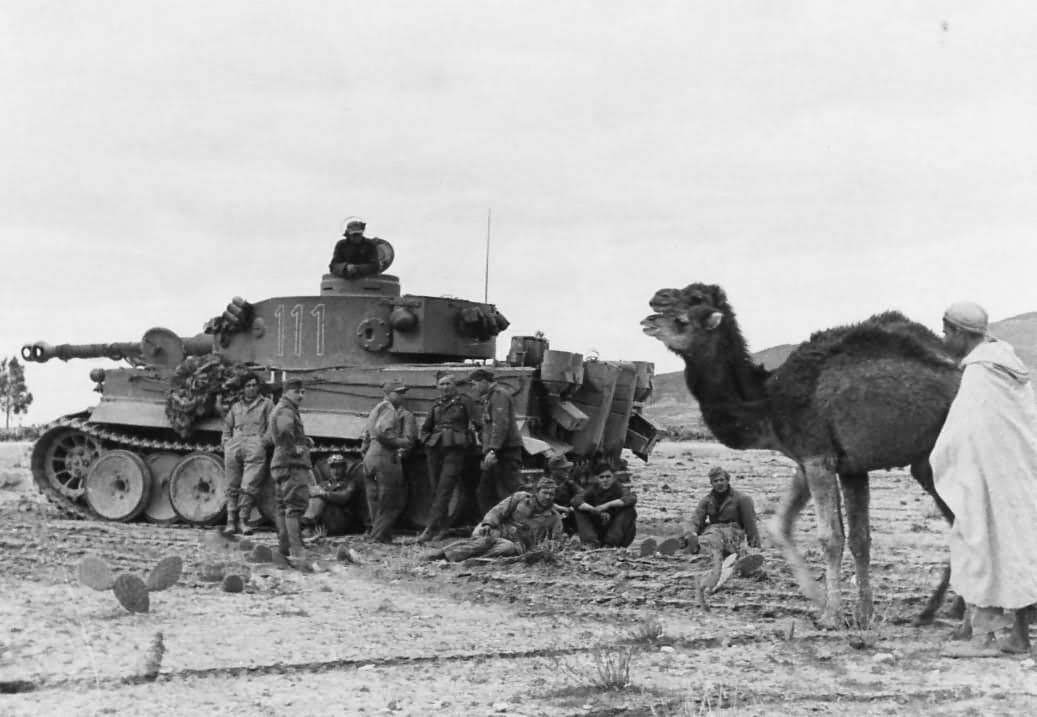Not saying you should watch it, but you would need to go 15 min or 20 just to start with what he is stating. Gotta get past the Rommel part.
The “Myth of Wittmann” is an interesting question.
It is worth noting that the German’s exploited individual tank commander success in much the same way, as was common in all militaries, as they exploited fighter pilot “aces.” The Germans and the Soviets were the only two militaries that did this - creating “tank aces” - to such a large extent.
Exploring the creation of propaganda themes and why particular themes are more or less effective with particular target audiences would probably be a “spirited” discussion here. LOL!
I might observe, from my own point of view, that standards and expectations for performance of the air ace versus the tank ace provides some clues and suggestions as to why Wittmann, for all of his prowess as an individual tank commander, could not transition that performance to higher levels of command.
The fighter ace does his job initially as part of a larger unit, but as aerial combat is joined, the fight usually devolves into a number of concurrent, individual engagements. The fighter units, flights and squadrons mostly, are also not operating in the moment as close members of a larger, task organized, combined arms unit.
When the Germans made a propaganda hero out of Wittmann, they were forced by their own actions into trying to make something greater and greater out of him. It was not enough that he continue as a highly successful individual tank commander, but that he be elevated in rank to platoon, company and, ultimately, battalion (Abt.) command. However, these higher levels of leadership demand different skill sets and ways of thinking that don’t translate directly from the individual tank commander’s cupola.
The fighter ace, even as flight or squadron leader, ends up joined in individual combat like almost every other fighter pilot in the “fur ball.” The tank platoon leader, tank company commander and tank battalion commanders should only ever rarely be engaged in tank-on-tank combat. Their jobs are to plan, coordinate, direct and lead ALL of the tanks under their command, not just their own, and do so from before the battle begins, through the combat phase, and beyond to its branches and sequels.
Wittmann (and the Germans) was a victim of his own success. He was no doubt a hugely competent and successful individual tank commander, but I’m not so impressed with his leadership performance outside of the cupola.
It is interesting to note the difference in the way the Allies treated their tank “aces” compared to the Germans. The Allies it would seem, generally recognized that promotion to platoon, company and battalion command required totally different skills and competencies than those needed to fight individual tanks. I believe there was also more of an appreciate of the “team effort” needed fight a tank, so the Allies generally emphasized how each member of the crew contributed to the success rather than just giving the tank commander all the credit.
So, yea, SGT Schmedlap might be a great tank commander, he (and his crew) might have even “scored” more than five enemy tank kills, but all that usually meant was that his tank earned the “honor” of taking point next time it’s his tank’s turn.
I don’t know nor care how well Wittmann did as commander.
LazerPig, as a history content creator, refuses to cite sources in many of his videos, and straight up insult people who “oppose” him, as in asking for the source of the information. Very cherry picking and miss matching information under the “technically correct”. Like some vehicle models hadd issues, but fixed in later models. for him, if it had issues, it has to stay on the vehicle forever.
That’s really not how thing works. He is not short than the German Nazi propaganda equivalent.
As I said, I don’t know or know nor care how well Wittmann did as commander. Despite I have a Tiger miniature with decal for Wittmann’s tank in the box, I never use that because Wittmann is never the subject of interest for me, nor any war hero for that matter.
I cannot see a guy, who say so much false, fabricated and cherry picking information on equipment technical and minimal source listing to giving correct history.
It is ok to point out what was more possibly real and false based on account of different people, different angles. LazerPig’s version of the story is more in line with more recent collection of information on the event. Nevertheless, using fabricated “facts” is not the way to go. Calling some British account lying even though the situation was not a walk in the park, as noted above, both sides were unprepared.
As TopSmith wrote above: “Propaganda works best if you start with truth, then embellish.” What LazerPig is doing overall is no difference.
This video is from another topic from another guy (he was an actual tank commander btw), check the comment section to see a familiar name.
It is more or less an reaction to LazerPig claims of 100% certainty on the technical of Russian T-14 Armata, a tank that most of the enthusiast don’t even know its capacity. Yet, LazerPig refuses to cite any thing to back it up other than “Trust me bro”. It just doesn’t work for me.
The books that the other members here recommended are much better than that youtube video, which the video is based on in the first place.
Correct, he wasn’t although many people thought he was. In fact Bobby Woll survived the war. I think he died in the 90s. He also wasn’t Wittman’s gunner at Villers Bocage, he had been promoted to command of his own vehicle, despite a mis-reported dialogue between them about the British thinking the war was over, “Well we’re going to show them it isn’t” which appears in Paul Carell’s “Invasion, They’re Coming!”. There can be no doubt that Wittman was an excellent individual tank commander (although the German top scorer was actually Kurt Knispel of Heer sPzAbt 503, who, unlike Wittman was anything but a Nazi or a propaganda pin up, as he affected a beard and long hair. He didn’t even receive the Knight’s Cross despite his successes.) and like all the best crews, there seemed to be almost a telepathy between him and Woll, while Woll was serving as his gunner. It is noteworthy that Wittman was killed as temporary battalion commander leading an ill-judged counter attack against Cintheaux.
That seems right on the mark from what my reading & research found on Kurt. There was some interesting info on Kurt on the Axis History Forum back in the day. Definitely didn’t seem like the type of personality well suited to the lock step mentality of Hitler’s Germany.

FWIW - I think Kurt did end up in one famous video clip of King Tiger’s
Definitely not the poster boy.
A shame he got killed. I’ll bet he would have been great for the Bundeswehr’s Armor Corp.
Or by the looks and description, a good candidate for the US’s First Special Forces.
True for so many. My friends Dad was killed ten days earlier… He is buried in Germany, his Father (my friend’s Grandfather) is buried in France.
I believe Knispel’s exhumation and re-burial in 2013 attracted quite a bit of attention, largely positive. He was, after all, a local lad.
Cheers,
M
Was googling western WW 2 tank aces and found this…
Tank and AFV News: Canadian Tank Ace Radley-Walters Passes Away. He was the top #1 Western Tank Ace of WW2.
His comments on Wittman, whom he faced several times in combat may be relevant to the the threads Wittman discussion.
According to an article from the Whig-Standard, Radley-Walters was indifferent to the historical record, remembering the feared leader of the 101 Schwere SSPanzerabteilung as a worthy and determined foe. “He was a superb tanker.” “I had tangled with him two or three times and let me tell you, when you fought against his group, you were challenged by a wonderful group of commanders.” “I never had any use for the German administration that started the war but they had some of the best generals, and I hope the next time we go to war, they’re going to be fighting on our side.”
There’s also a fairly valid sounding argument that Radley-Walter’s unit took out Wittman’s Tiger and killed him.
I really have no idea why you’d think folks haven’t read Panzer Tactics and many other books.
Panzer Tactics? Read it over a decade ago.Card carrying member, here’s the proof of it.
The 1970’s view of Wittman…as I personally experienced it…information was far less available then…here’s mine experience with two commonly available points of interest. Sure some folks blow up the Wittman hype but I think it’s pretty rare (not impossible just rare) for anyone paying attention to even limited 1970’s information to do that.
-
In like ~1977, when building Tamiya’s 1/25 Tiger 1, the 88 kill decal and reference to Wittman on the instructions was pretty darn impressive.
-
Avalon Hill’s fantastic gamette Cross of Iron expansion for Squad Leader had Wittman as a 9-2 leader tank ace. Otto Carius was a 10-2, Barkman a 9-1. Can’t remember if Knipsel was included also as a 10-2
Note a 10-3 was the BEST and Wittman wasn’t rated as such. In the game a 9-2 leader is formidable and dangerous.
The best that is 10-3 leader looks like this…Major Winters…

I don’t think anyone with even a semi-serious background in WW2 history would ever confuse Wittman with a truly outstanding leader.
For what it’s worth nearly every major nation in WW2 had a few rare 10-3 leaders. Everyone also had a couple of 7-0’s or even 6+1 which is the very worse rating.
Dey got dem sum 1st rate internet informations & fakt finders
It’s just across the border in Antarctica beside Brazil which is north of Ireland but east of China.
![]()
Not to mention the immense heat needed to heat that shell during the extremely short period of time it travels through the gun barrel after being fired. That barrel would need to be glowing cherry red to heat the shell in that short time …
Another factor to consider is the political environment.
The strategically correct decision could have been to fall back, abandon the village for a shorter or longer period of time while defending the hill.
The political situation may have required defence to the last bullet of every single village or hamlet.
A tactically sound decision may be strategically wrong and the strategically correct action may be totally wrong from a political perspective.
Abandoning your position to fall back and be able to fight again could lead to an execution squad for cowardice.
Making the right decision isn’t always so easy as it may seem 50 or 500 years later.
That’s probably a Pz4 that identifies as a Tiger ![]()
Jokes apart, what unit is that tank from? They seem to have done some field mods to the rear plate. Would those be jerry cans on the rear right?
Nope, It’s a T-34 masquerading as a Tiger during a Soviet false flag attack on Iraq.
They did this in order to scare the Iraqis away from their friendship with Germany.
Trust me, I have very reliable sources but I will not reveal them here.
![]()
According to this site it was from Schwere Panzer Abteilung 501
I read the book Operation Nordwind back in the early 90’s during a winter in Graf… Its a Great Read. It goes on to tell just how fragile the Allied alliance really was. And gives the soldiers perspective from both sides.
I’m beginning to think the waters are getting a little muddied here.
To my mind it is clear that Wittman was a highly experienced tank commander, and on 13th June 1944 was just perceptive and ballsy enough to realise that prompt, and I really mean immediate, action was required. He did what he did as he really had no other choice. A CO of a (Brit) armoured regiment once remarked to me that he required his soldiers to think at 40 mph, and I believe that was what Wittman was doing early that Tuesday morning.
He may not have been as tactically adroit (in his role as company commander required) but he was astute enough to initiate action, and that counted that day.
7th Armoured Div had certainly been fighting in various theatres for far too long and in this case, had become sloppy and drills ignored. But the divisional vanguard of 4 CLY presented a clear threat to the Germans and Wittman had perceived that.
It is perhaps worth recalling the British view at the war’s end (and I’ve copied this out - rather laboriously):
“At half-past five the next morning the advance continued through Briquessard and Amaye-sur-Seulles. Villers Bocage was entered without incident, although the 11th Hussars and 8th Hussars had both contacted the enemy on either side of the centre-line. ‘A’ Squadron of the 4th City of London Yeomanry and ‘A’ Company of the 1st Rifle Brigade then pushed on according to plan towards the high ground to the north-east of the town. In order to clear the traffic on the roads behind, the column had to move out comparatively closed up, and it was this that gave a Mk. VI tank, which suddenly appeared from a side road, its opportunity. Its first shot destroyed one of the Rifle Brigade half-tracks, thus blocking the road; and then at its own convenience it destroyed the remainder of the half-tracks, some Honey tanks of the Recce troop, four tanks of the Regimental Headquarters troop and the two OP tanks accompanying the squadron. Escape for the tanks, carriers and half-tracks was impossible; the road was embanked, obscured by flames and smoke from burning vehicles whose crews could only seek what shelter they could from the machine gun fire, and our own tanks were powerless against the armour of the Tiger, with limitless cover at its disposal. Meanwhile ‘A’ Squadron, in the lead with the Commanding Officer, were cut off. Their last radio message, received at half-past ten, reported that they were completely surrounded by tanks and infantry, that the position was untenable and withdrawal impossible. Relief was equally impossible as, in addition to the burning tanks and vehicles, the road was blocked by the same Mk. VI which commanded all approaches.”
(A Short History of 7th Armoured Division; Sept. 1945)
Action was required and had a quality all of its own that day. Wittman was the initiator of it and he was responsible for the stalling of a divisional advance; let’s just consider that – a divisional advance.




